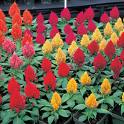
I had a plant dilemma this weekend at the local big box stores. It’s nothing new; I have this same problem every year. The stores offer all sorts of tender plants at very good prices 15-30 days before they will do well in the garden. The problem is compounded by the fact that when the time is right the stores will be sold out. So, I agonize and fret but in the end I usually buy at least some of the plants with the resolve that I will truck them in and out of the house every day until the night time temperatures warm up and I can plant them out. The major problem is that as the temperatures warm up and the breezes blow, the plants in small containers like 6 packs dry out and can be lost in a careless afternoon.

Here is my strategy for this year. First I divided the plants into two groups. One group can be planted out and will grow well right after the last frost date, usually within 2 weeks. In this group I put such plants as sweet alyssum and petunias. They are no-brainers. I leave them in their original containers, place them where I am most likely to water them and take them inside only when frost threatens. I will usually have take them in and out only a couple of times until the last frost date arrives. The second group is the more difficult one. The plants can be planted out after the frost-free date but will sit there and languish. They may change color, they may survive, but they will not grow and some may even die waiting for warm nights. In this group are such heat loving plants as marigolds, ageratum, salvia, celosia, portulaca, vinca, and impatiens. I know that I will have to both water them daily and carry them in and out every night. I am willing to do this if I fall in love with a certain color and/or must have a particular height of that plant, etc. In addition, I must feel very sure that the plant will not be available again in the stores (this is the big if and creates the dilemma.) The chosen few will get a royal makeover; repotting in a larger pot, usually 4” or whatever I have around. I use a mix of garden soil, perlite, and peat moss but any decent soil would be fine as these plants usually have good root systems and are garden ready when I buy them. In the larger pots, they do not dry out as easily as in the 6 packs and watering them is easy. I keep the pots in the trays 4” pots come in so bringing them inside for cool/cold nights is not a big problem. At the end of the 4 weeks or so I have turned my $1.69 6 pack into six $1 pots and they are bigger, bear more blooms, and have better root systems than they had when I bought them or would have had if I had planted them immediately in the garden. My efforts yielded a 3-fold increase in value. The repotting takes a little time but sometimes there are bonuses. Yesterday I did three 6 packs of celosias and found that almost every cell had two plants instead of one. Because they were young and small I could easily separate them and so increased my purchase by 75%. That is a nice little bonus for sitting in the sun repotting.

I may have overlooked this information but could you tell me what zone you grow in, thanks. Enjoying your blog1
I garden in zone 7b in the Piedmont area of North Carolina. I used to live and garden in Annapolis, MD and it is also zone 7b but has very different weather. Both share the same “lowest temperature” but have many aspects of temperature and climate that are different. The USDA zones are really just guidelines and any given garden can have microclimates that will make or break plants that are marginally hardy. I have done posts on AHS heat zones, USDA zones, and frost free dates, all archived under Garden Basics. Thanks for your comments and coming to my site.
I have have to large celosia plants growing outside my house that i planted this year but i was wondering is it possible to transfer them to a pot and keep them inside for the winter to keep them alive?
Maxie,
Celosias are natives of tropical areas in Ashia, Africa, and America and are considered tender annuals. You might be able to prolong its life and bloom by bringing your plant inside but a more productive alternative would be to harvest the tiny seeds and start new plants. My celosias do this themselves and I almost always a a bunch of volunteers in both the garden and the pots in which I grow them. One caveat, however, the volunteers are not always as full and pretty as the parents. Also, celosias like warm temperatures so if you keep your house on the cool side they may not grow and bloom as you expect.
Karen